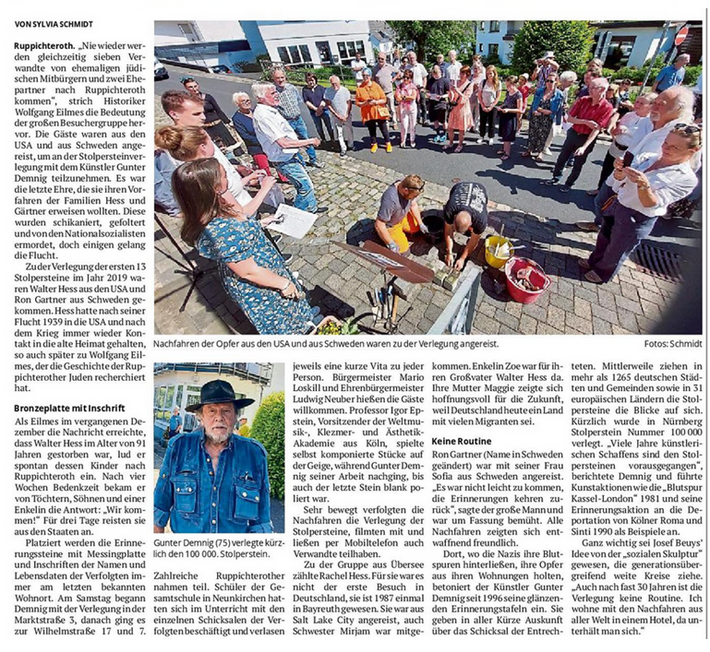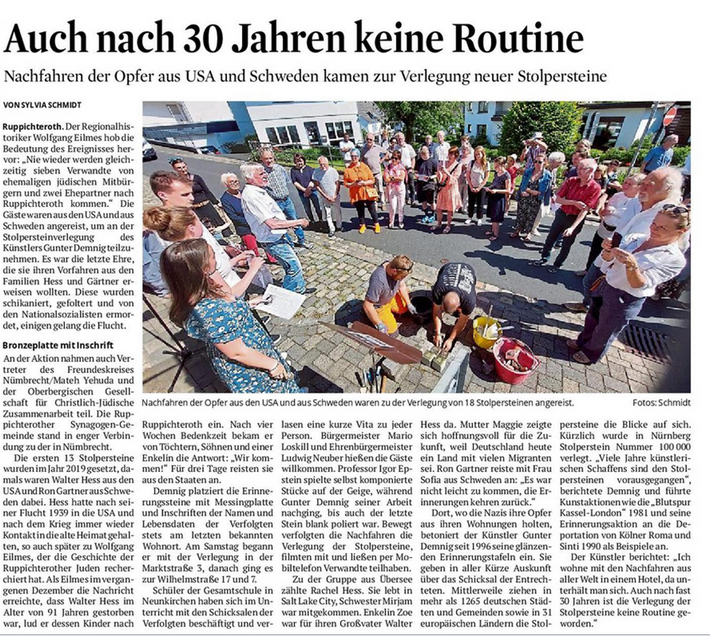Translation of the article for our English speaking readers:
Stumbling Stones against Forgetting
Descendants of the victims had traveled from the USA and Sweden
BY SYLVIA SCHMIDT
Ruppichteroth. "Seven relatives of former Jewish fellow citizens and two spouses will come to Ruppichteroth at the same time," emphasized historian Wolfgang Eilmes the significance of the large group of visitors. The guests had traveled from the USA and Sweden to participate in the laying of Stumbling Stones with the artist Gunter Demnig. It was the final tribute they wanted to pay to their ancestors from the Hess and Gärtner families. They were harassed, tortured, and murdered by the Nazis, but some managed to escape.
During the laying of the first 13 Stumbling Stones in March 2019, Walter Hess from the USA and Ron Gärtner from Sweden had come. After fleeing to the USA in 1939, Hess had maintained contact with his old homeland, including later with Wolfgang Eilmes, who researches the history of Ruppichteroth.
Bronze plaques with inscriptions
When Eilmes received the news last December that Walter Hess had passed away at the age of 91, he spontaneously invited his children to Ruppichteroth. After four weeks of consideration, he received the answer from the daughters, sons, and a granddaughter: "We're coming!" They traveled from the United States for three days.
The commemorative stones with brass plates and inscriptions of the names and life dates of the persecuted are placed at the last known place of residence. On Saturday, Demnig began the laying at Marktstraße 3, followed by Wilhelmstraße 17 and 7.
Numerous Ruppichteroth residents participated. Students from the comprehensive school in Neunkirchen had studied the individual fates of the persecuted in class and read a short biography for each person. Mayor Mario Loskill and Honorary Mayor Ludwig Neuber welcomed the guests. Professor Igor Epstein, chairman of the World Music, Klezmer, and Aesthetics Academy from Cologne, played self-composed pieces on the violin while Gunter Demnig continued his work until the last stone was polished.
The descendants watched the laying of the Stumbling Stones with great emotion, filmed it, and shared it with relatives via mobile phones. Among the overseas group was Rachel Hess. It was not her first visit to Germany; she had been to Bayreuth in 1957. She had traveled from Salt Lake City, and her sister Mirjam had also come. Granddaughter Zoe was there for her grandfather Walter Hess. Her mother Maggie expressed hope for the future because Germany is now a country with many immigrants.
No routine
Ron Gartner (name changed in Sweden) had traveled with his wife Sofia from Sweden. "It was not easy to come; the memories return," said the tall man, trying to remain composed. All the descendants were disarmingly friendly.
Where the Nazis left their bloodstains and dragged their victims from their homes, the artist Gunter Demnig has been embedding shining commemorative plaques since 1996. They provide brief information about the fate of the persecuted. Stumbling Stones now attract attention in more than 1,265 German cities and municipalities, as well as in 31 European countries. Recently, Stumbling Stone number 100,000 was laid in Nuremberg. "Many years of artistic work preceded the Stumbling Stones," Demnig reported, citing art actions such as the "Blood Trail Kassel-London" in 1981 and his commemorative action for the deportation of Roma and Sinti from Cologne in 1990 as examples. The idea of the "social sculpture" by Josef Beuys is of great importance.
Translated by Wolfgang Eilmes
Kölner Stadt-Anzeiger - Ausgabe Oberberg 6.6.2023
Am Dienstag, d. 6.6.2023 erschien ein inhaltlich leicht veränderter Artikel auch in der Oberbergischen Ausgabe des Kölner Stadt-Anzeigers:
Translation of the article for our English speaking readers:
Even after 30 years, no routine
Descendants of the victims from the USA and Sweden came for the installation of new stumbling blocks
By Sylvia Schmidt
Ruppichteroth. The regional historian Wolfgang EiImes emphasized the significance of the event: "Never again will seven relatives of former Jewish fellow citizens and two spouses come to Ruppichteroth at the same time." The guests had traveled from the USA and Sweden to participate in the installation of stumbling blocks by the artist Gunter Demnig. It was the final honor they wanted to pay to their ancestors from the Hess and Gärtner families. They were harassed, tortured, and murdered by the Nazis, and some managed to escape.
Bronze plate with inscription
Representatives of the Nümbrecht/Mateh Yehuda Friendship Circle and the Oberbergische Society for Christian-Jewish Cooperation also took part in the action. The Ruppichterother synagogue community had a close connection to the one in Nümbrecht.
The first 13 stumbling blocks were installed in 2019, with Walter Hess from the USA and Ron Gartner from Sweden being present at the time. After fleeing to the USA in 1939, Hess maintained contact with his old homeland, including later with Wolfgang Eilmes, who researches the history of the Ruppichteroth people. When Eilmes received the news last December that Walter Hess had died at the age of 91, he invited his children to Ruppichteroth. After four weeks of consideration, he received the response from his daughters, sons, and granddaughter, "We will come!" They traveled from the United States for three days.
Demnig places the commemorative stones with brass plates and inscriptions of the names and life dates of the persecuted individuals always at their last known place of residence. On Saturday, he started with the installation at Marktstraße 3, and then proceeded to Wilhelmsstraße 17 and 7.
Students from the comprehensive school in Neunkirchen have studied the fates of the persecuted individuals in their classes and read a short biography for each person. Mayor Mario Loskill and honorary mayor Ludwig Neuber welcomed the guests. Professor Igor Epstein played pieces he composed himself on the violin while Gunter Demnig continued his work until the last stone was polished. The descendants closely followed the installation of the stumbling blocks, filming and sharing with relatives via mobile phones.
Among the overseas group was Rachel Hess. She lives in Salt Lake City, and her sister Mirjam came along. Granddaughter Zoe was there for her grandfather Walter Hess. Mother Maggie expressed hope for the future because Germany is now a country with many migrants. Ron Gartner traveled from Sweden with his wife Sofia, saying, "It was not easy to come; the memories return."
Where the Nazis dragged their victims out of their homes, the artist Gunter Demnig has been embedding his shining commemorative plaques since 1996. In brief, they provide information about the fate of the persecuted. Stumbling blocks now draw attention in more than 1265 German cities and municipalities, as well as in 31 European countries. Recently, the 100,000th stumbling block was installed in Nuremberg. Demnig reported, "Many years of artistic work preceded the stumbling blocks," and cited examples such as the "Blutspur Kassel-London" in 1981 and his commemorative action for the deportation of Cologne's Roma and Sinti in 1990.
The artist said, "I live in a hotel with descendants from all over the world, so we talk. Even after almost 30 years, the installation of stumbling blocks has not become routine."
Translated by Wolfgang Eilmes




